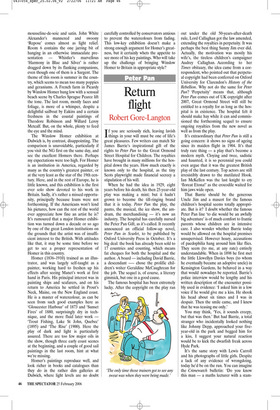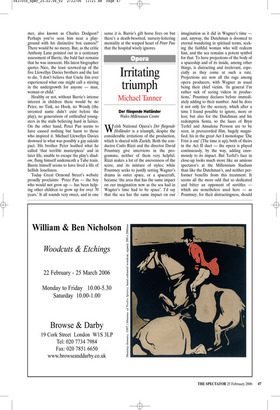Return flight
Robert Gore-Langton
If you are seriously rich, leaving lavish things in your will must be one of life’s great pleasures. Few writers can match Sir James Barrie’s inspirational gift of the rights to Peter Pan to the Great Ormond Street Hospital for Children. The royalties have brought in many millions for the hospital down the years. How much exactly is known only to the hospital, as the tiny Scots playwright made financial secrecy a stipulation of his will.
When he had the idea in 1929, eight years before his death, his then 25-year-old play was making a mint; but it hadn’t grown to become the till-ringing brand that it is today. Peter Pan the play, the panto, the musical, the ice show, the amdram, the merchandising — it’s now an industry. The hospital has carefully nursed the Peter Pan Gift, as it’s called. It recently announced an official follow-up novel, Peter Pan in Scarlet, to be published by Oxford University Press in October. It’s a big deal: the book has already been sold to 17 countries and counting, which means fat cheques for both the hospital and the author. A board — including David Barrie, a descendant –— chose the prolific children’s writer Geraldine McCaughrean for the job. The sequel is, of course, a literary gimmick, but one in a good cause.
The famous hospital has been extremely lucky. After the copyright on the play ran out under the old 50-years-after-death rule, Lord Callaghan got the law amended, extending the royalties in perpetuity. It was perhaps the best thing Sunny Jim ever did. Actually, the motivation was mostly his wife’s, the tireless children’s campaigner Audrey Callaghan. According to her Times obituary, the idea came from a correspondent, who pointed out that perpetual copyright had been conferred on Oxford University for Clarendon’s History of the Rebellion. Why not do the same for Peter Pan? ‘Perpetuity’ means that, although Peter Pan comes out of UK copyright after 2007, Great Ormond Street will still be entitled to a royalty for as long as the hospital is in existence. The hospital felt it should make hay while it can and commissioned the forthcoming sequel to ensure ongoing royalties from the new novel as well as from the play.
It’s extraordinary that Peter Pan is still a going concern: it shows no signs of ageing since its maiden flight in 1904. It’s that truly rare thing — a play that’s become a modern myth. Cloying and twee, sadistic and haunted, it is so perennial you could even argue that it was the greatest British play of the last century. Top actors are still irresistibly drawn to the mutilated Hook. Ian McKellen was the last knight to cry ‘floreat Etona!’ as the crocodile waited for him jaws wide open.
That Barrie should be the generous Uncle Jim and a mascot for the famous children’s hospital seems totally appropriate. But is it? I doubt whether the famous Peter Pan line ‘to die would be an awfully big adventure’ is of much comfort to frantic parents whose children are in intensive care. I also wonder whether Barrie today would be allowed on the hospital premises unsupervised. However hoary, accusations of paedophilia hang around him like flies. They seem (to me, at any rate) entirely understandable. When in 1898 he first met the little Llewellyn Davies boys (to whom he eventually became an adoptive uncle) in Kensington Gardens, he behaved in a way that would nowadays be reported. Barrie’s police interview would be lengthy and his written description of the encounter possibly used in evidence: ‘I asked him in a low voice if he would give me a kiss. He shook his head about six times and I was in despair. Then the smile came, and I knew that he was teasing me only.’ You may think, ‘Yes, it sounds creepy, but that was then.’ But had Barrie, a total stranger who incidentally looked nothing like Johnny Depp, approached your fiveyear-old in the park and begged him for a kiss, I suggest your natural reaction would be to kick the dwarfish freak across Hyde Park.
It’s the same story with Lewis Carroll and his photographs of little girls. Despite a lack of any evidence of wrongdoing, today he’d be on the run. You can imagine the Crimewatch bulletin: ‘Do you know this man — a maths lecturer with a stam mer, also known as Charles Dodgson? Perhaps you’ve seen him near a playground with his distinctive box camera?’ There would be no mercy. But, as the critic Anthony Lane pointed out in a centenary assessment of Barrie, the bald fact remains that he was innocent. His latest biographer quotes Nico, the least screwed-up of the five Llewellyn Davies brothers and the last to die, ‘I don’t believe that Uncle Jim ever experienced what one might call a stirring in the undergrowth for anyone — man, woman or child.’ Healthy or not, without Barrie’s intense interest in children there would be no Peter, no Tink, no Hook, no Wendy (the invented name didn’t exist before the play), no generations of enthralled youngsters in the stalls believing hard in fairies. On the other hand, Peter Pan seems to have caused nothing but harm to those who inspired it. Michael Llewellyn Davies drowned in what was possibly a gay suicide pact. His brother Peter loathed what he called ‘that terrible masterpiece’ and in later life, unable to escape the play’s shadow, flung himself underneath a Tube train. Barrie himself seems to have lived a life of hellish loneliness.
Today Great Ormond Street’s website proudly proclaims: ‘Peter Pan — the boy who would not grow up — has been helping other children to grow up for over 70 years.’ It all sounds very sweet, and in one sense it is. Barrie’s gift horse lives on but there’s a death-besotted, nursery-loitering mentality at the warped heart of Peter Pan that the hospital wisely ignores.



































































 Previous page
Previous page